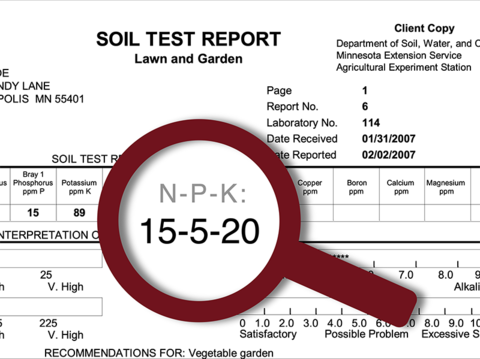Your lawn, garden and flowering plants need nutrients to grow healthy roots and leaves and to produce flowers or fruit. Nitrogen (N), phosphorus (P) and potassium (K) are the three primary nutrients your plants require. Nitrogen promotes leaf growth, phosphorus supports root growth and fruiting, and potassium helps your plants resist disease and stay hardy.
Fertilizing your garden properly means providing enough of the nutrients your plants need without supplying too much. This helps not only your plants and your pocketbook, but it’s crucial for the environment. So how do you find the right product to buy?
Step 1: Test your soil
Testing your soil will help your garden flourish. It’s impossible to know how much nitrogen, phosphorus and potassium to add to your soil without first knowing what amounts are there already.
Collecting and sending a soil sample to the University of Minnesota Soil Testing Laboratory is easy, and the results arrive in two to three weeks.
Step 2: Know your ratio
On the front of your soil test report, you’ll see your recommended N-P-K amounts expressed as a ratio. This ratio is the proportion of macronutrients recommended for your specific soil. Now that you have this information handy, you can shop for the right solution.
Find out how to submit a soil sample for analysis.
Step 3: Find the right option
Fertilizers, by law, show the N-P-K ratio on the front of the bag, but other soil amendments may or may not. Choose a product with an N-P-K ratio close to your soil test report, without going over on P.
For example, if your report recommends a ratio of 15-5-20, try to find a fertilizer or compost product with that ratio. If your only choices are 15-10-20 and 13-0-0, choose the 13-0-0 option. The level of nitrogen (13) is close, and the phosphorus (0) doesn’t go over.
Phosphorus overuse is a serious environmental concern. It can leach into waterways and affect downstream ecosystems. In fact, in Minnesota it’s illegal to use phosphorus on lawns in many circumstances.
If you need extra nitrogen, you can supplement your fertilizer with a nitrogen-only amendment like feather meal, blood meal or alfalfa seed meal.
We can help
Following the recommendations from your soil test makes caring for your flowers or garden much easier. If you need help interpreting your results, or if you have other questions about your garden, flowers or lawn please reach out to an Extension Master Gardener volunteer.
The soil testing lab also has help for interpreting your results. And you can print out this factsheet to have on hand when you shop for fertilizer.
Reviewed in 2023



